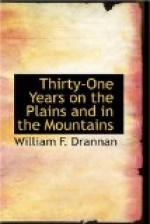He then asked me if they could get to the head of the ravine that the Indians were camped on and not be seen by them. I told him that I could show them a ravine that led from the emigrant trail to the head of the valley on which they were camped, and marked out a plat of the country in the dust, showing the course each company would have to take, telling them that the company making the upper attack would have to travel about a mile farther than the one making the attack from below. He then asked me if the companies could see each other before the Indians could see them. I informed him that they could not, but that I could show him a hill where he could station a man and he would be able to see both companies, but the Indians could not see him, and when the company from above should reach the top of the hill that man could signal to the other company to charge.
At that time Lieut. Harding turned to Capt. Mills and said: “If the boy scout will go with me I will make the upper attack, as he has been over the country and knows the lay of the ground.”
Of course I consented, and we marched to the mouth of the ravine just mentioned.
I pointed out the hill referred to, and the Lieutenant placed a man on top of it, and we proceeded.
Just before we reached the top of the other hill, Lieut. Harding halted and formed his men in line, placing them about ten feet apart, saying: “I have only a hundred soldiers, but I want it to appear that I have a thousand.”
When we first came in sight of the Indians, some were lying stretched out in the sun, some were sitting down, while a few were out looking after their horses, everything indicating that they had just had their breakfast and were lounging around, not having the slightest idea of an enemy in twenty miles of them, and we took them wholly unawares.
When the Lieutenant formed his men in line before raising the top of the hill, he asked me to take charge of his left wing and he would take charge of his right. As soon as we came in sight of the Indians, he gave the order to charge.
This was the first thing of the kind I had ever witnessed, and when I cast my eyes down the line of soldiers I thought it the grandest sight I had ever seen. This was also the first engagement for either of the companies.
In all the scrimmages I had been in with the redskins, the one that made the most noise was the best Indian fighter; so when the Lieutenant gave the order to charge, I raised a yell, as I thought this to be one of the essential points of a charge, and wondered why the rest of the boys did not do the same. However, after hearing a few of my whoops they picked it up, and each began yelling at the top of his voice, and by this time we were among the Indians.
The two companies had about the same distance to run after sounding the charge, but Lieut. Harding was at the scene of conflict a few moments ahead of Capt. Mills, thereby giving the Indians time to scatter. This was attributed to the fact that Capt. Mills had to charge up grade while Lieut. Harding had down grade, which they had not thought of before making the arrangement, and the ground being mostly sand made a great difference in the speed of the horses.




